Fill up your cup at Innisfree Garden, part 1
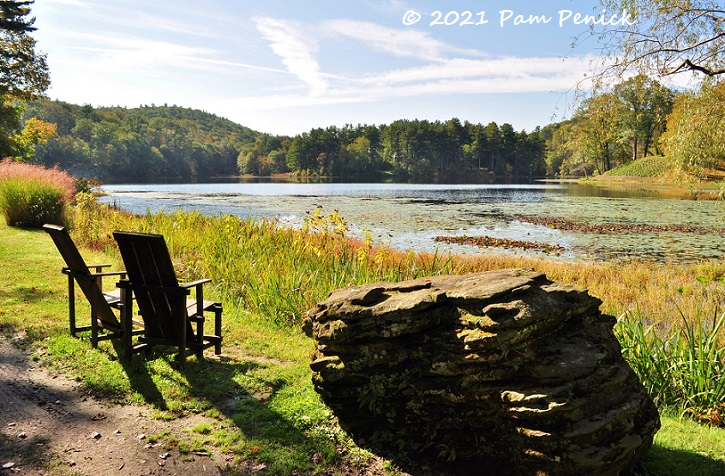
“Pam, I hope you are planning a visit to Innisfree, the world’s greatest underrated and too little known garden.” So messaged James Golden of Federal Twist after I’d asked if I might visit his own increasingly well-known garden while on my Northeast road trip in October. As it happened, Innisfree was on my itinerary. And if not, I’d have added it on James’s recommendation alone.

Even though I’d worked out a snaking sightseeing route from Maine through New Hampshire and Vermont to get here, I knew next to nothing about Innisfree Garden. Located near the charming village of Millbrook, New York, where David and I stopped for lunch, Innisfree is a former private estate and 60-year-old public garden somewhat refreshingly devoid of glamour or visitor amenities. You won’t find a grand old manor house here. It was torn down decades ago. You won’t find a gift shop or café either. Two porta-potty toilets, a ticket kiosk, and picnic tables are the only public-garden concessions on offer.
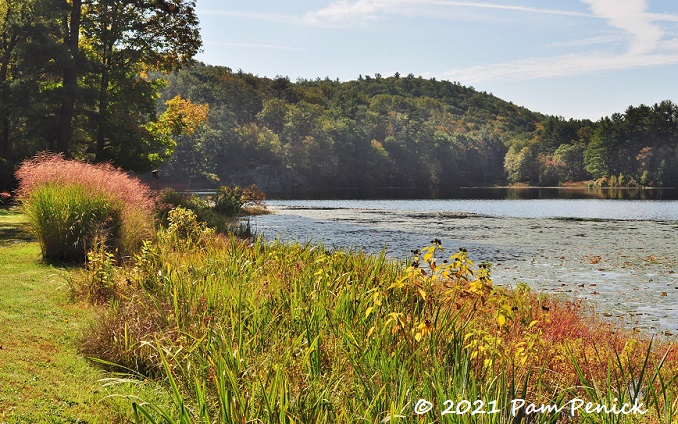
But you won’t miss those things. (Well, maybe real toilets.) What you will find is a contemplative, engaging strolling garden around a glacial lake, planted with sturdy native and well-adapted trees, shrubs, perennials, and grasses that don’t require a platoon of gardeners to maintain. You’ll also find, if you wander about, interesting and sometimes mysterious “cup gardens” — inward-focused gardens or vignettes inspired by scroll paintings of ancient Chinese gardens.
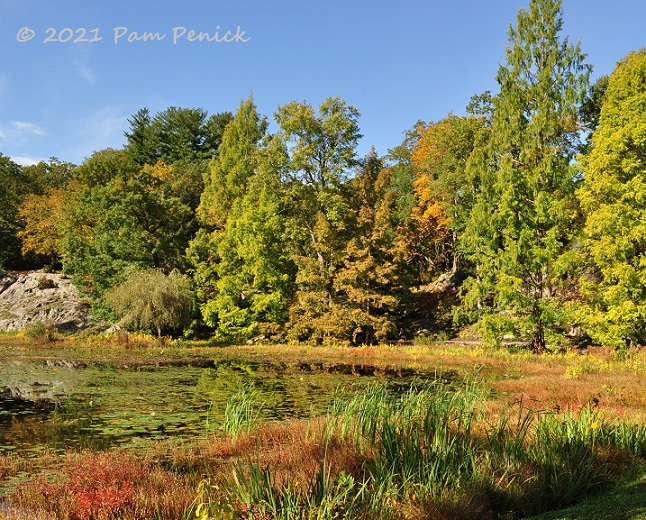
Innisfree’s founders, Walter and Marion Beck — he was the mystical artist with a passion for garden design; she was the money, a lumber baron heiress as well as an avid gardener — began working with landscape architect Lester Collins in 1938 to create the garden. For 20 years they collaborated, rejecting the original plan for an English-style garden to complement the Becks’ new English-style house in favor of a Chinese-influenced strolling garden.
When the Becks died without heirs, Collins kept on with the garden as director of its foundation. Over the next 30 years he simplified the overall design for easier maintenance, extended a walking path around the lake to make a loop, and added other significant features. He also razed the Becks’ mansion, which was expensive to keep up and, in his view, didn’t suit the garden’s aesthetic. After his death, his wife, Petronella, took over and kept the garden going until 2017. Recently the garden’s significance as “a postmodern masterpiece” led to its listing in the National Register of Historic Places. Even so, as James Golden noted, the garden remains little known.
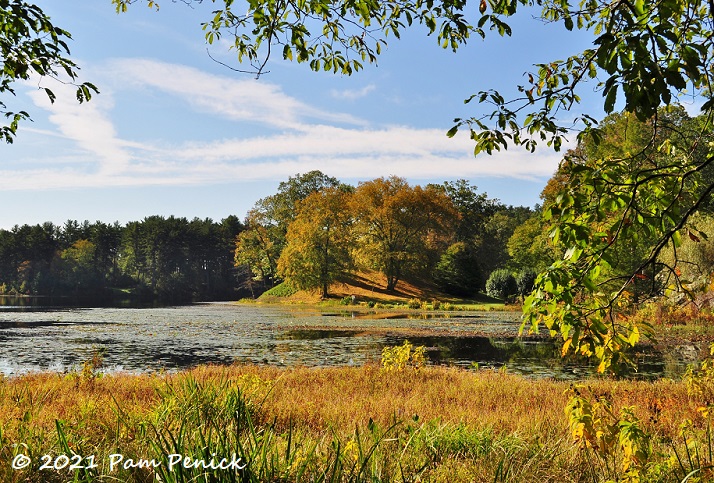
So let’s get to know it! We arrived at opening time on the morning of October 8th, after a two-hour drive from Bennington, Vermont (finding an affordable motel or hotel near Millbrook had proved challenging). From the parking area you walk down to the lake, where a broad view of water and wooded hills gives you a sense of leaving urban life far behind.
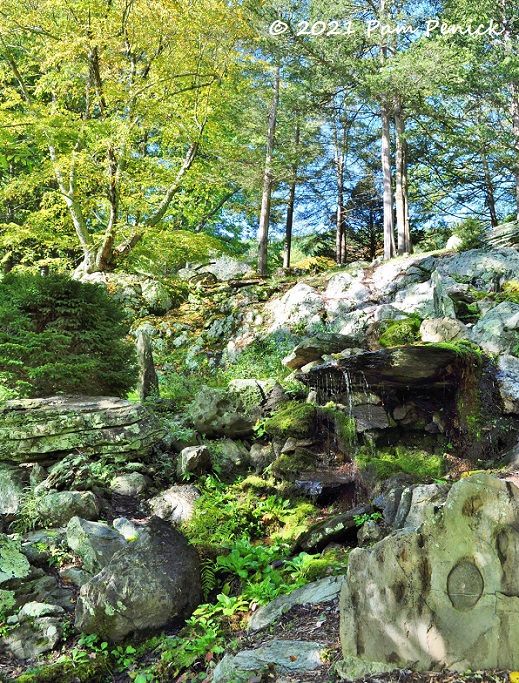
The woodsy path leads along the base of a boulder-studded hill, and then you hear a dripping waterfall — one of the cup gardens. A beaded curtain of water hangs from the lip of a jutting rock at aptly named Lip Rock Waterfall.
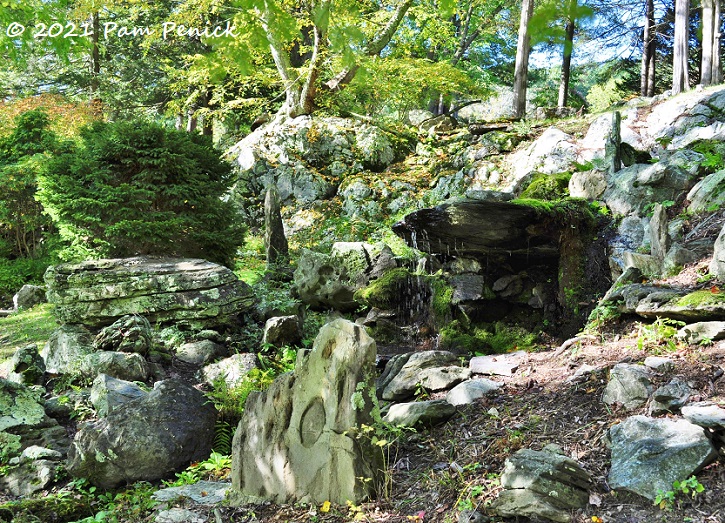
Unusually shaped and marked rocks stand upright here and there, like spirit guides.
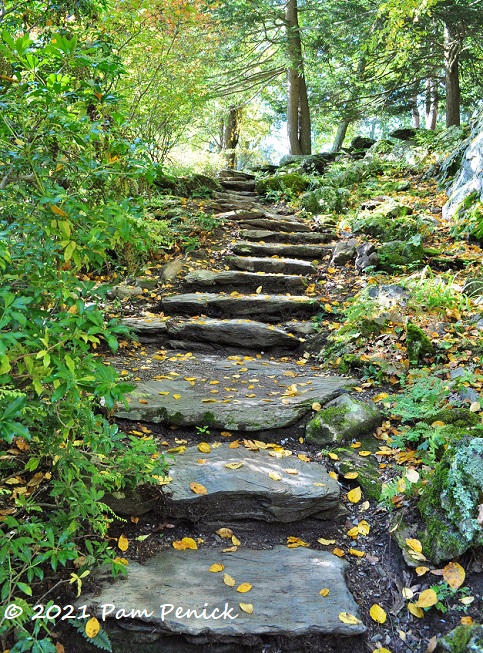
Soon we found ourselves climbing shallow stone slabs to the top of a knoll.
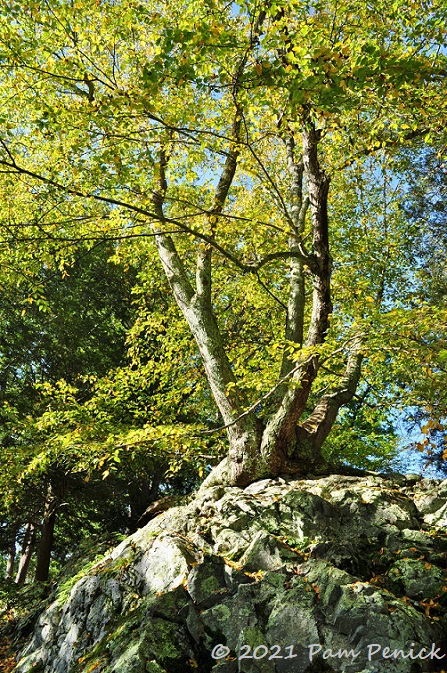
Trees turning autumn hues perch here too, their roots dug deep into rocky crevices.
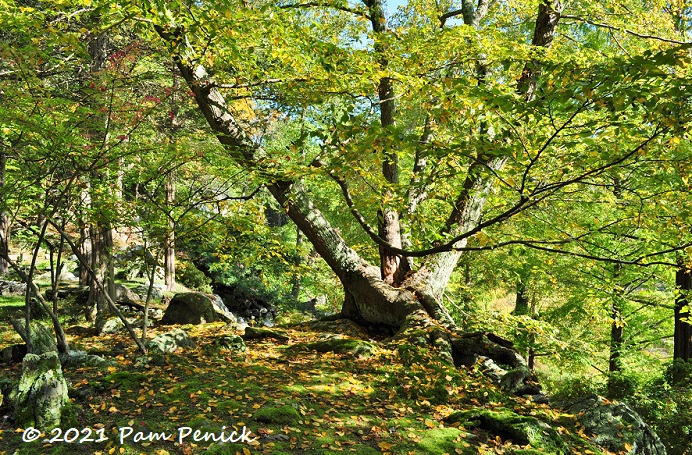
A mossy glade makes a pretty canvas for falling leaves. It was hard to discern where the path was up here, and I worried we’d gone off-trail, but we soon picked it up again.
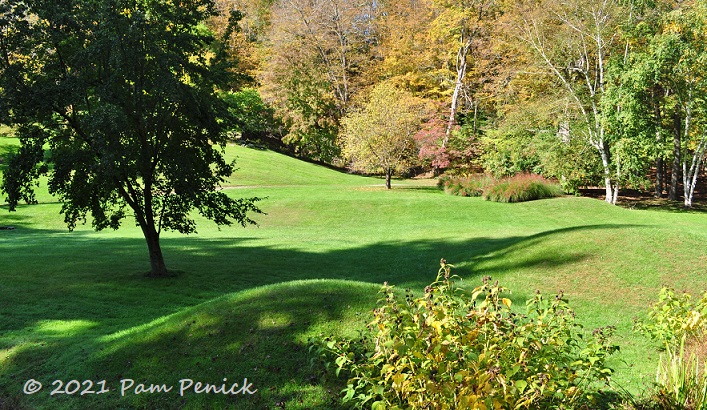
I’m skipping over an interesting cup garden in dappled shade at Tiptoe Rock that defied my picture-taking skill. We diverged from the lakeside trail to explore the North Lawn, where an interesting view opened up: lumpy, grassy berms with a backdrop of trees turning orange and gold.
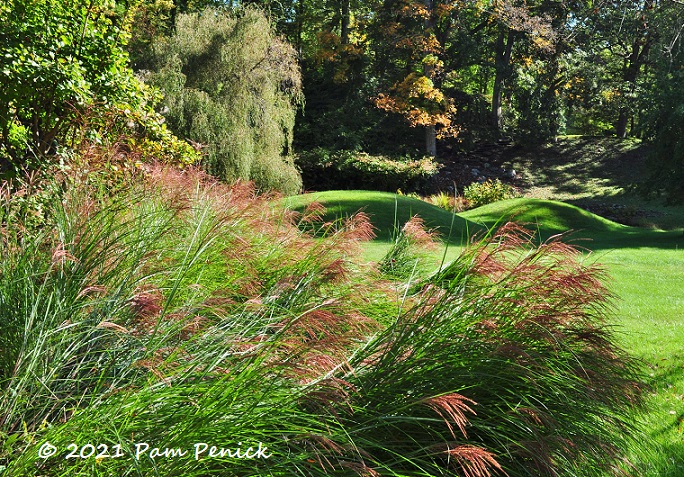
The lawn looked like a green bedspread pulled over down pillows. We walked down the pillows — the path had vanished — and explored the “bed.”
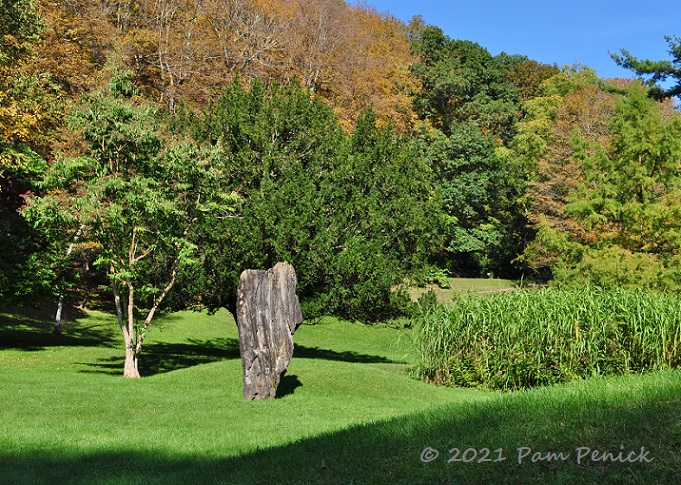
A large standing stone near another berm attracts the eye.
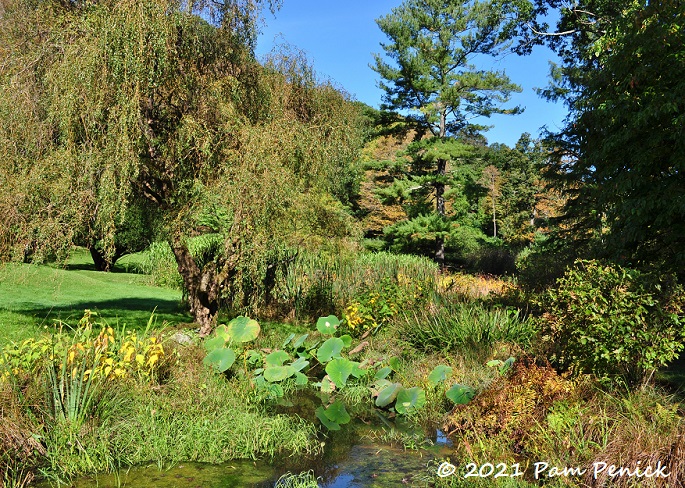
Tucked amid the berms, a lotus pond bog garden was going orange and yellow.
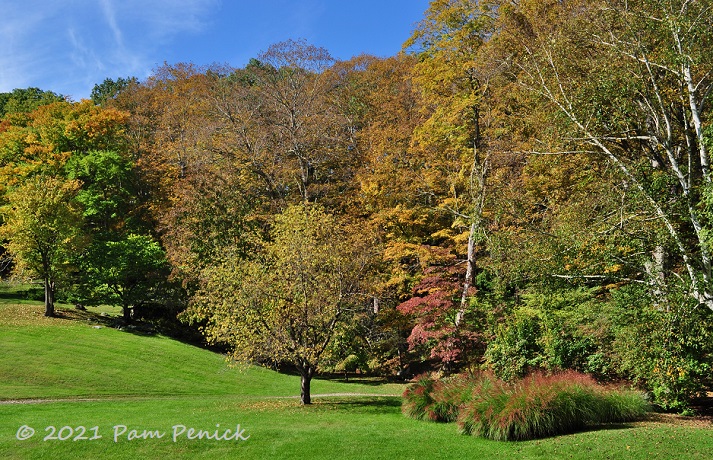
More beautiful fall color
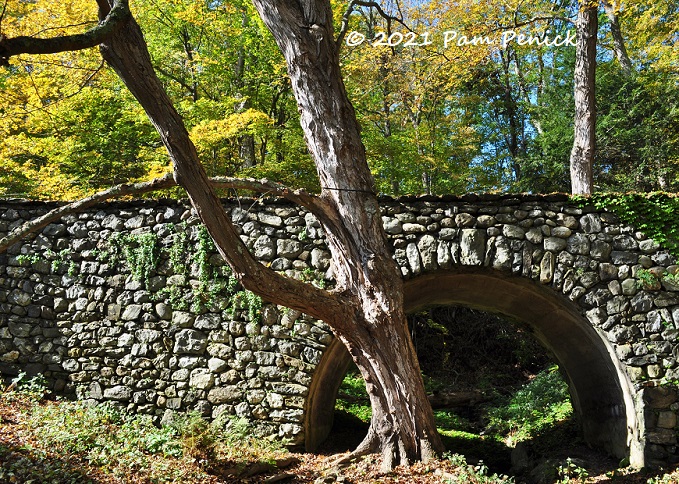
A cobblestone bridge arch surrounded by golden trees caught my eye and we wandered over.
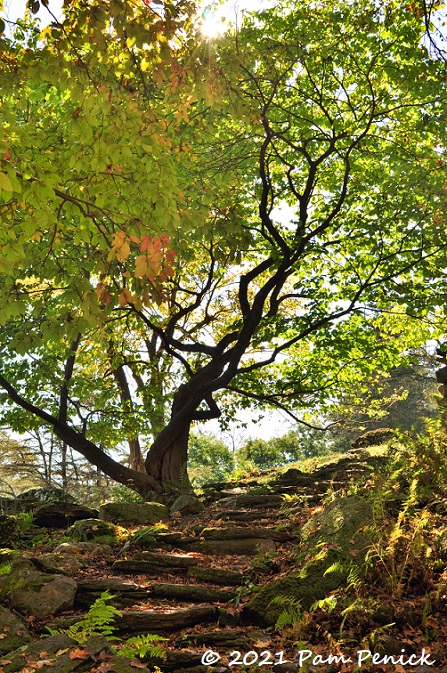
Another stone stair appeared, curving uphill under a gracefully bent tree.
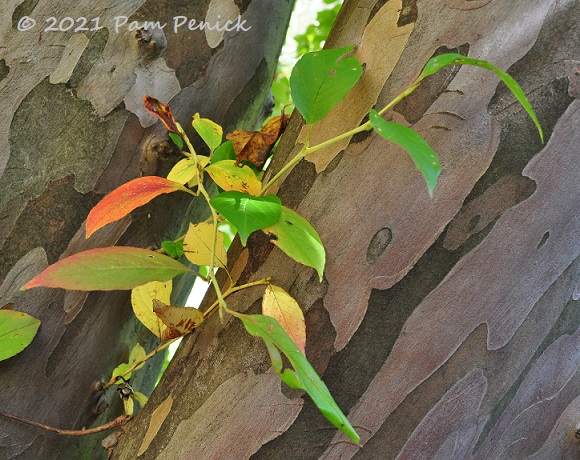
Bark and leaves
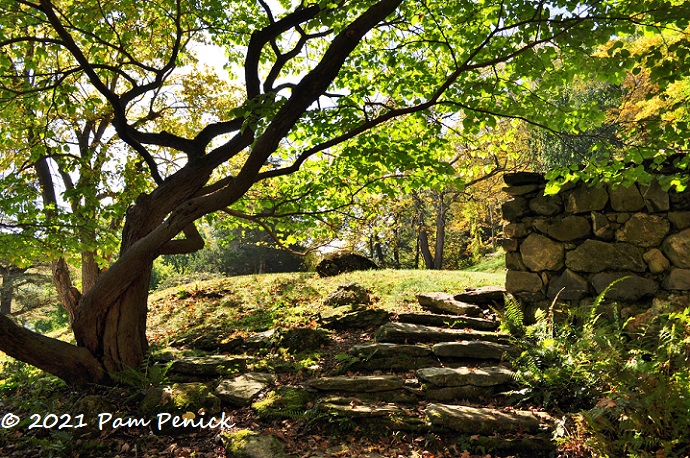
As we reached the top we looked left…
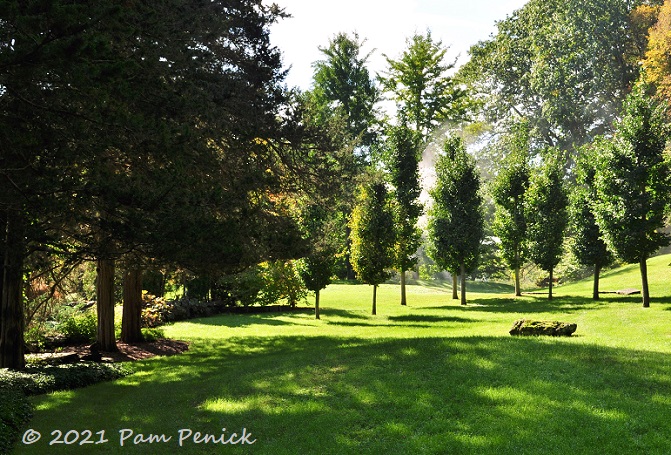
…and saw another interesting scene, a bosque of fastigiate trees with mist rising behind them.
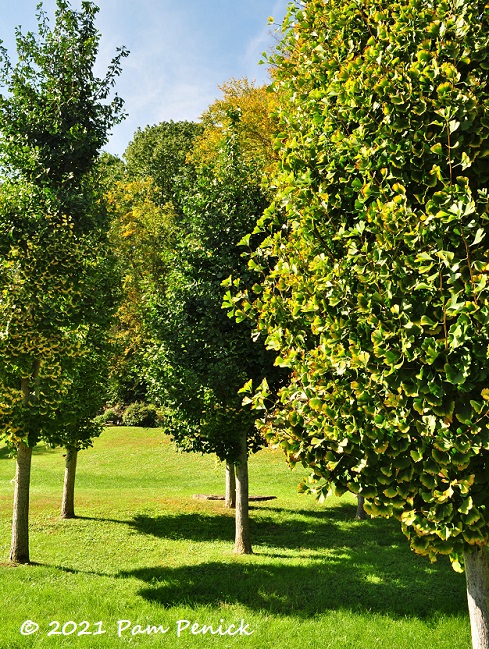
Fastigiate ginkgos!
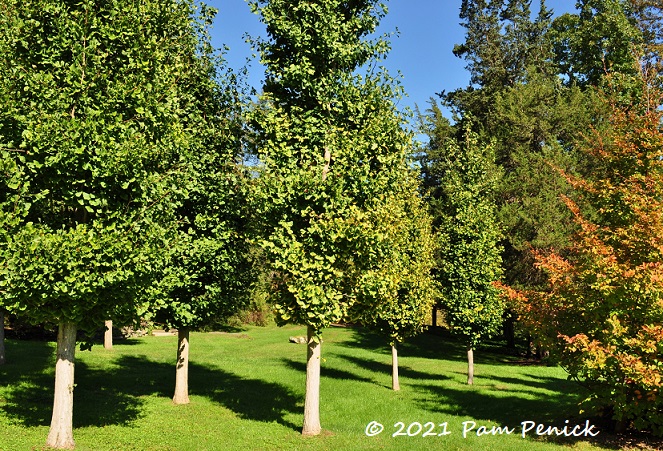
Just imagine how they must look in their golden glory a little later in October.
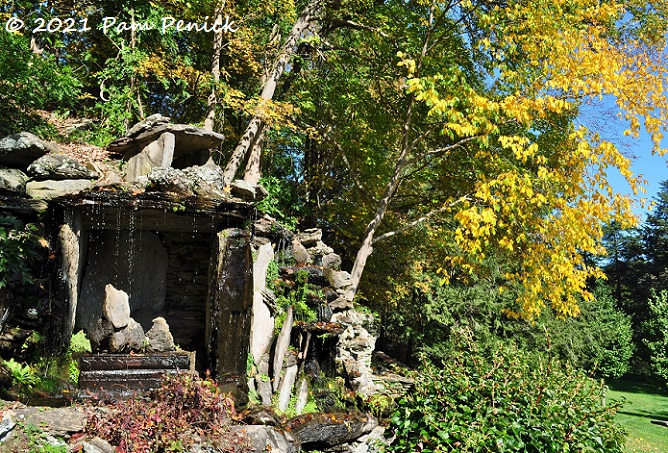
Another trickling water curtain drew us to the edge of a wooded hillside, where we found Buddha Cave, a rocky grotto.
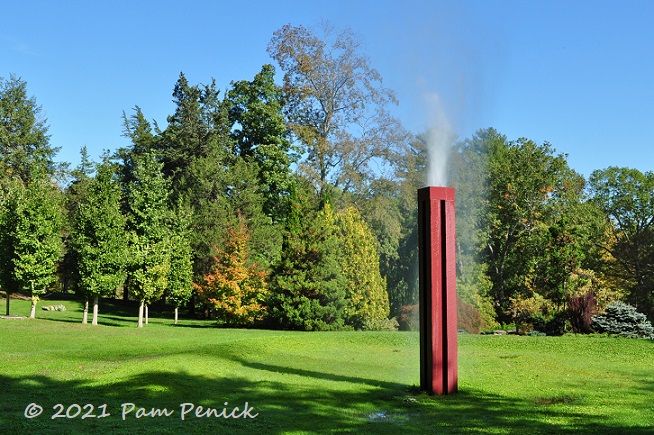
Opposite, a contemporary water sculpture shoots a vaporized jet of water skyward. The red column stands alone in a shallow bermed circle.
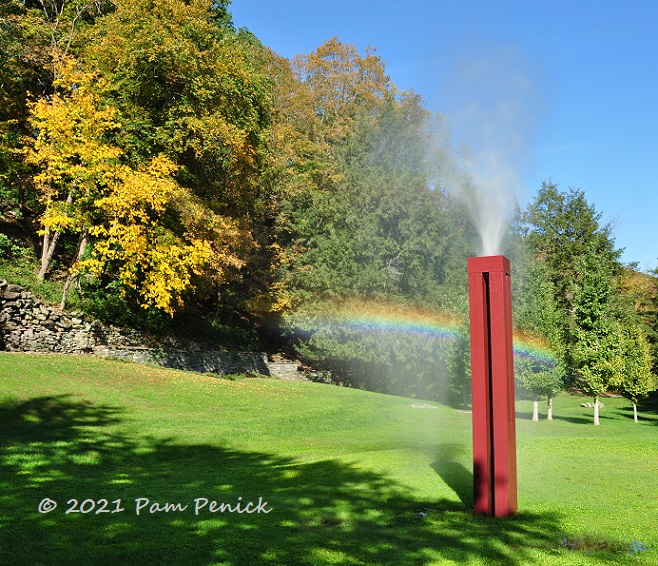
From certain angles, the mist makes a rainbow.
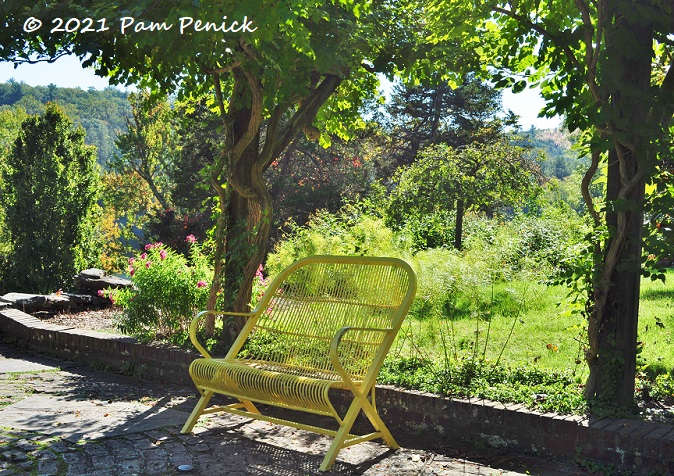
A brick terrace offers shady seating under a vine-draped arbor. The yellow bench must make a wonderful color echo with the nearby ginkgos when they turn.
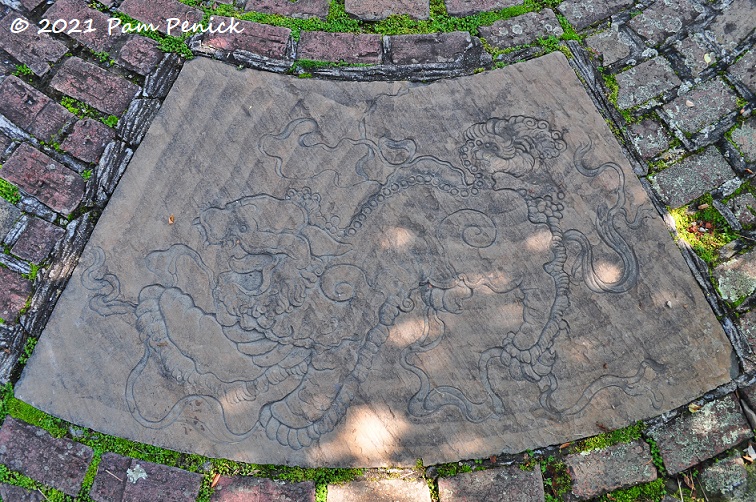
I read somewhere that this terrace is all that remains of the Becks’ inappropriately English house. Inset stones depict Chinese imagery that suits this garden.

Beyond the yellow bench, the arbor frames a view of the red water sculpture.
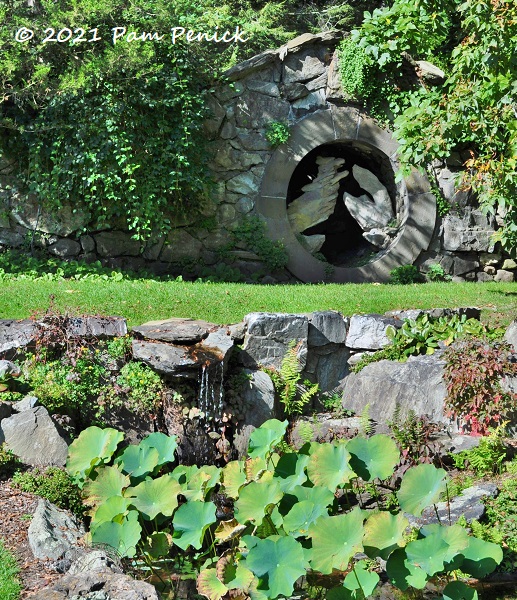
We soon came across another lotus pool with a small waterfall. Just beyond, an arched stone wall contains the Circular Grotto.
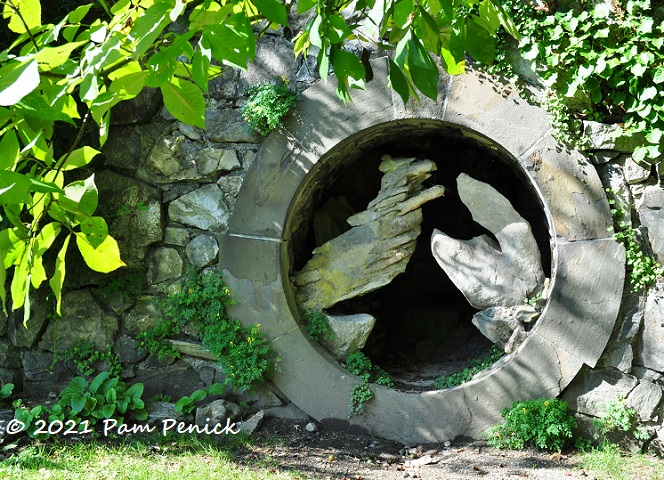
Angled stones, vaguely animal shaped, seem ready to battle, the left one with outstretched arms, the other with a gaping maw? Or do you see something different?
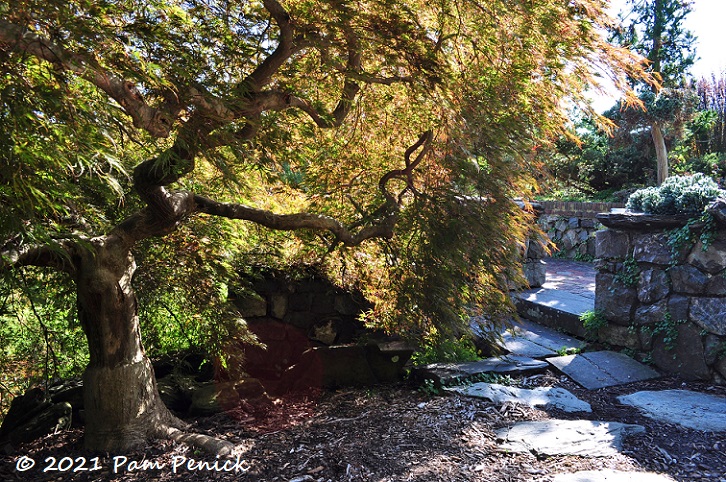
A rusty-leaved Japanese maple points the way to the Middle Terrace.
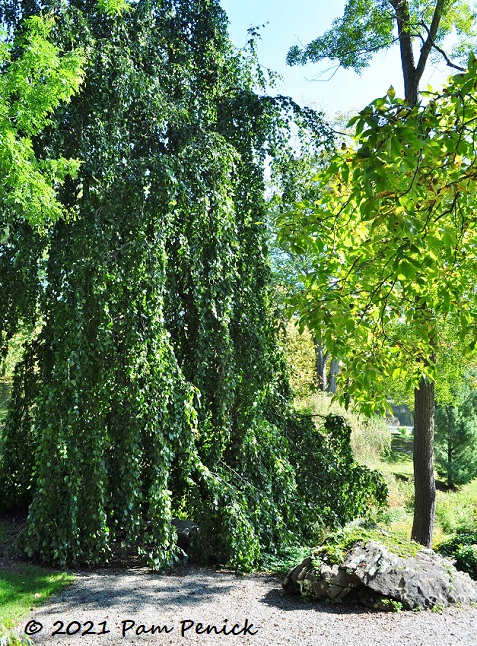
I can never resist peeking under the skirt of a weeping tree. They always remind me of a child’s secret hideaway.
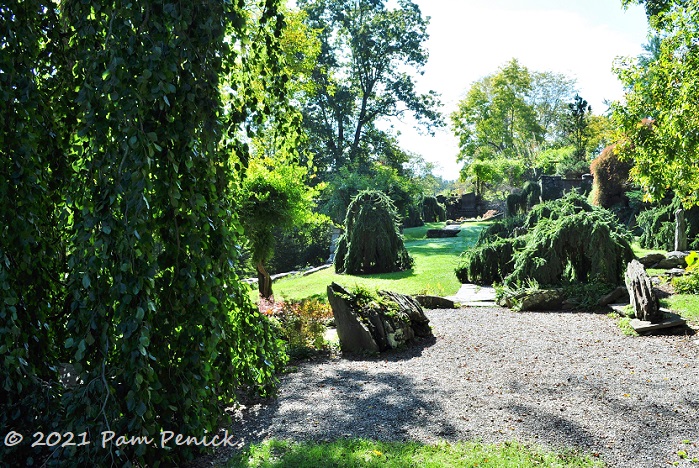
Other weeping trees, like so many hunching figures, can be seen on the lawn.
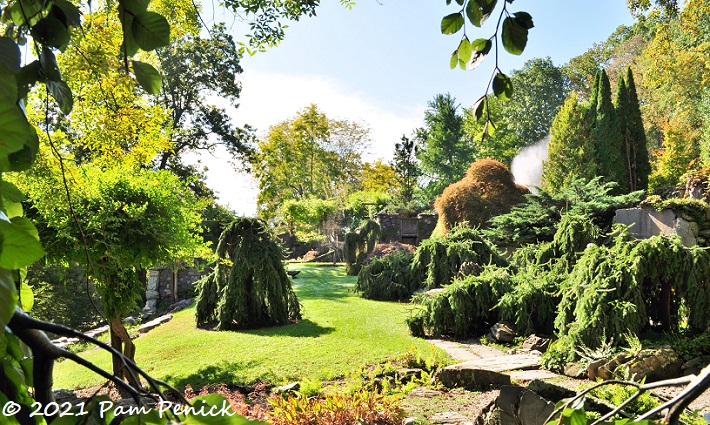
Don’t they give a melancholy appearance? Maybe they miss the house, or its former occupants.
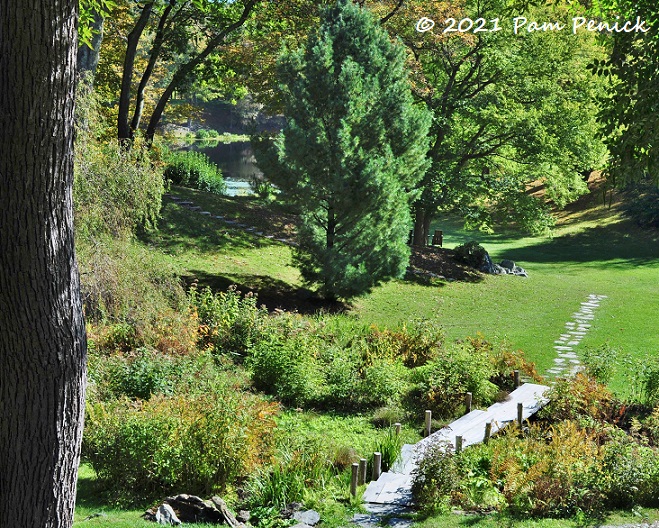
Below the terrace wall, a piered wooden bridge crosses a stream. Stepping stones then trail off in the lawn.
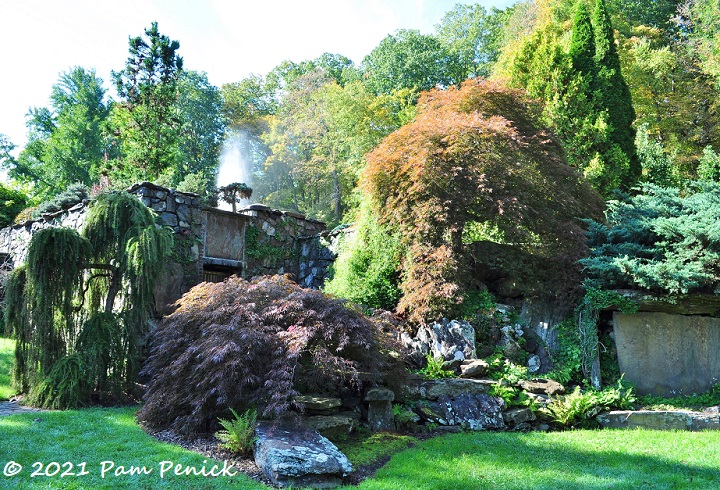
But let’s explore the rest of the Middle Terrace, with its collection of Japanese maples and weeping trees. Here, as everywhere at Innisfree, rock forms the structure and focal points.
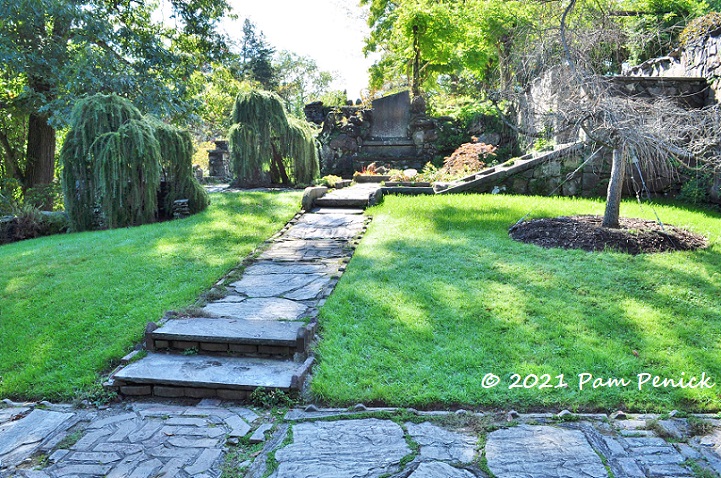
Romantic, melancholy weeping trees along a stone path
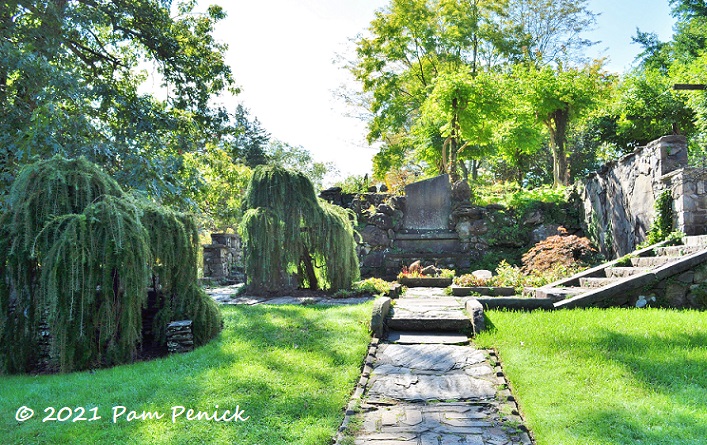
The walls look as if they could be the old home’s foundation, but perhaps they’re just made to look that way.
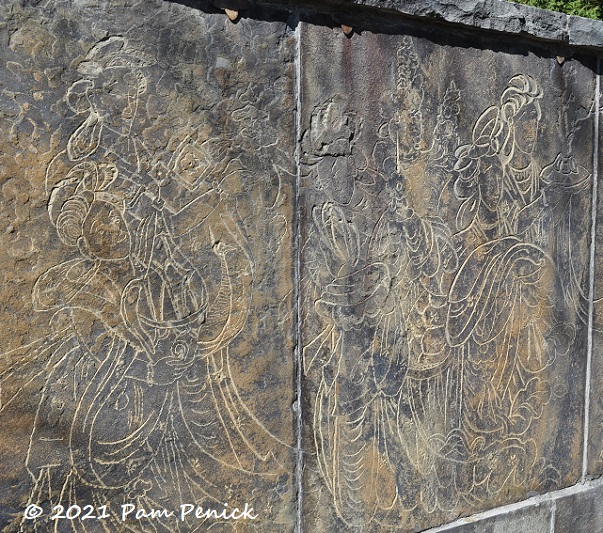
One wall is etched with Chinese-style figures. I wonder what story is being told.
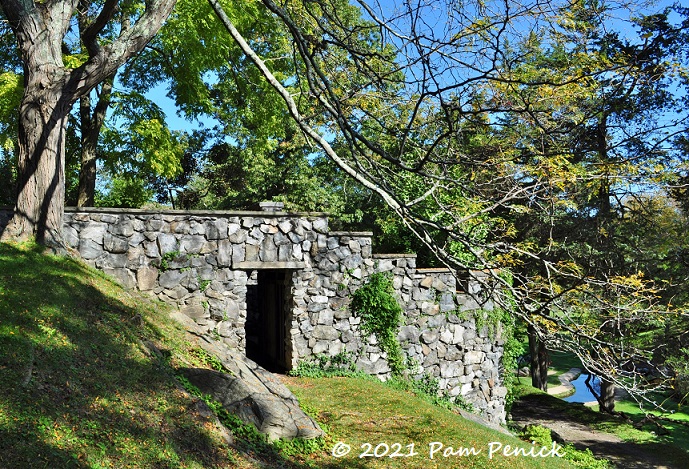
A cave-like room under the wall was open, so we popped inside to look. It seemed to be an old storage space.
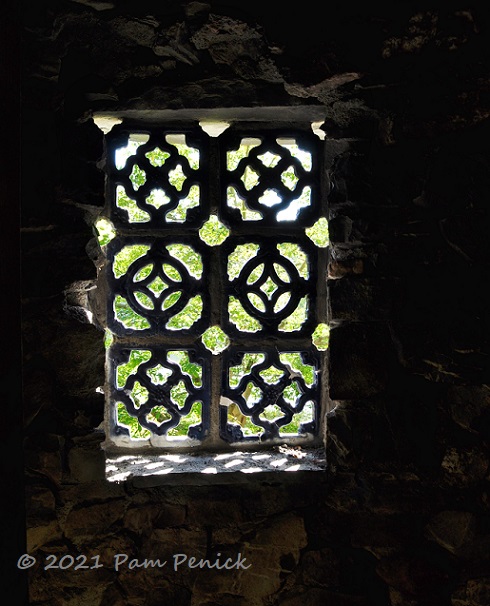
A Chinese tile window offered a little light.
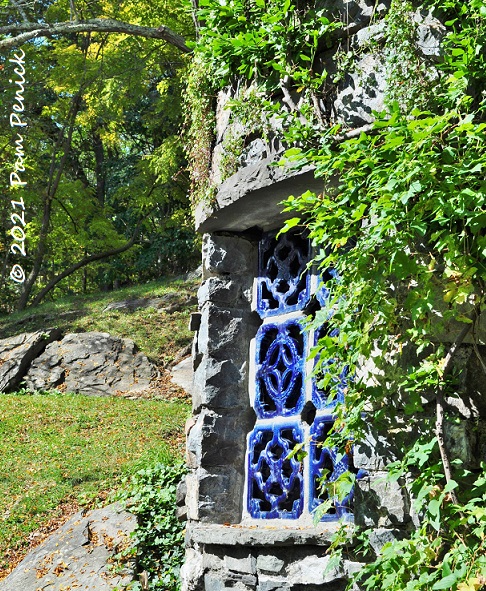
On the outside, the blue tile window and vine-draped stone walls give the place a fairy-tale vibe.
Up next: Part 2 of my stroll at Innisfree, including a wish tree, oxbow stream, and lakeside views. For a look back at the Green Mountains of Vermont in brilliant fall color, click here.
__________________________
Digging Deeper
Need design help with your yard? Hire me as your personal garden coach! Maybe you need replacement plant ideas after the big freeze. Or maybe your landscaping has grown tired, and you want fresh curb appeal. Or perhaps you’re ready to get rid of some lawn and create a pollinator garden, bird habitat, or hangout space for you and your friends. I’m here to help! Contact me to let me know what’s going on, and let’s figure it out together. My range is Austin and suburbs within a 25-min. drive of NW Austin, but I’m flexible and can travel farther with a surcharge, so let me know where you are. Weekday morning appts. only.
Come learn about gardening and design at Garden Spark! I organize in-person talks by inspiring designers, landscape architects, authors, and gardeners a few times a year in Austin. These are limited-attendance events that sell out quickly, so join the Garden Spark email list to be notified in advance; simply click this link and ask to be added. Season 8 kicks off in fall 2024. Stay tuned for more info!
All material © 2025 by Pam Penick for Digging. Unauthorized reproduction prohibited.


What an inspiring garden. I’d love to explore it in person.
I hope you’re able to one day, Laura.
So glad you were able to visit Innisfree. I agree with James; it is one of the great unknown treasures. Mark and I visited in the 1990s as we were starting our own garden. I can still recall so many features of the site and its atmosphere. And we loved the fact that we were almost the only ones there. (The same was true of our visit to Nitobe on the UBC campus; our favorite Japanese garden). We only have slides of Innisfree, so it was lovely to see your images. I signed up for a few ZOOM lectures from Innisfree last year which was a nice way to reconnect and support them.
Gardens that stay in your mind long years later are special indeed. And yes, the online lectures offered by gardens and organizations around the country have been one of the few bright spots resulting from the pandemic.
Very beautiful. The stone figures in the circular grotto made me think of a wolf encountering a dinosaur, perhaps exchanging a friendly hello in their respective ways rather than preparing to do battle 😉
I like the way you think, Kris. 🙂
What an interesting garden visit! The fact that the home is gone and you just see the old rock work (which may, or may not be part of the home) makes it very mysterious and keeps the focus on the garden, excellent! I am not familiar with the term “cup garden”, is this something you’ve heard before? Or it just seemed right to describe these small gardens?
The term “cup garden” was coined by Walter Beck, the original owner along with his wife, Marion. He used the term to describe inward-focused gardens and vignettes encountered throughout a naturalistic strolling garden — the type of garden he so admired in centuries-old Chinese gardens painted on scrolls. Through his study of such gardens, he was inspired to create Innisfree. You can read more about it here, on Innisfree’s history page: https://www.innisfreegarden.org/garden
I bet it would be fun to just stroll around this garden.
Yes, it definitely was.
What a treasure and another garden on the list!
There are so many. Aren’t we lucky? 🙂
I love following your travels and all the wonderful gardens! Don’t get to travel much anymore so your pictures help fill my cup. Many thanks for sharing with all of us!
Thank YOU for armchair-traveling along with me, Cissy!